语言学重点概念总结
语言学概论重点总结
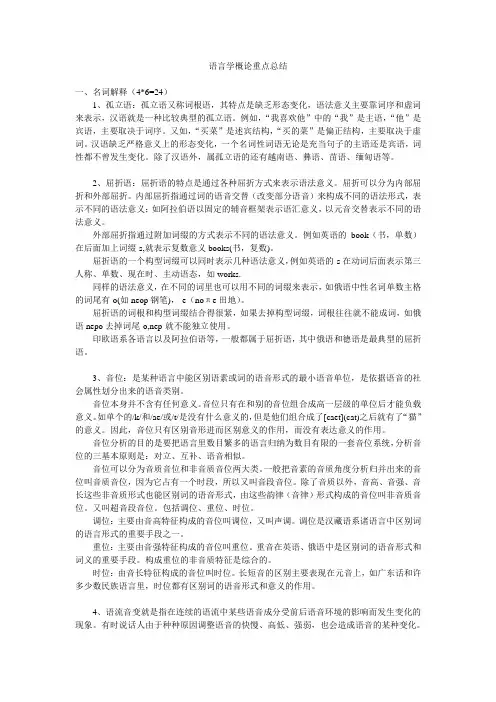
语言学概论重点总结一、名词解释(4*6=24)1、孤立语:孤立语又称词根语,其特点是缺乏形态变化,语法意义主要靠词序和虚词来表示,汉语就是一种比较典型的孤立语。
例如,“我喜欢他”中的“我”是主语,“他”是宾语,主要取决于词序。
又如,“买菜”是述宾结构,“买的菜”是偏正结构,主要取决于虚词。
汉语缺乏严格意义上的形态变化,一个名词性词语无论是充当句子的主语还是宾语,词性都不曾发生变化。
除了汉语外,属孤立语的还有越南语、彝语、苗语、缅甸语等。
2、屈折语:屈折语的特点是通过各种屈折方式来表示语法意义。
屈折可以分为内部屈折和外部屈折。
内部屈折指通过词的语音交替(改变部分语音)来构成不同的语法形式,表示不同的语法意义;如阿拉伯语以固定的辅音框架表示语汇意义,以元音交替表示不同的语法意义。
外部屈折指通过附加词缀的方式表示不同的语法意义。
例如英语的book(书,单数)在后面加上词缀-s,就表示复数意义books(书,复数)。
屈折语的一个构型词缀可以同时表示几种语法意义,例如英语的-s在动词后面表示第三人称、单数、现在时、主动语态,如works.同样的语法意义,在不同的词里也可以用不同的词缀来表示,如俄语中性名词单数主格的词尾有-o(如neop钢笔),-e(noπe田地)。
屈折语的词根和构型词缀结合得很紧,如果去掉构型词缀,词根往往就不能成词,如俄语nepo去掉词尾-o,nep-就不能独立使用。
印欧语系各语言以及阿拉伯语等,一般都属于屈折语,其中俄语和德语是最典型的屈折语。
3、音位:是某种语言中能区别语素或词的语音形式的最小语音单位,是依据语音的社会属性划分出来的语音类别。
音位本身并不含有任何意义。
音位只有在和别的音位组合成高一层级的单位后才能负载意义。
如单个的/k/和/ae/或/t/是没有什么意义的,但是他们组合成了[caet](cat)之后就有了“猫”的意义。
因此,音位只有区别音形进而区别意义的作用,而没有表达意义的作用。
语言学知识点总结
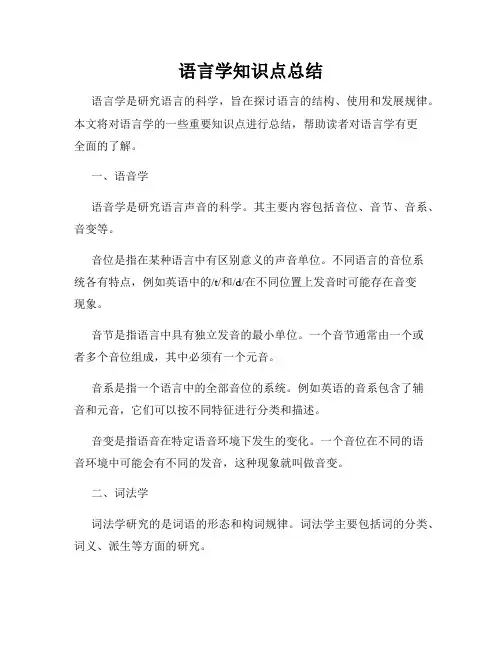
语言学知识点总结语言学是研究语言的科学,旨在探讨语言的结构、使用和发展规律。
本文将对语言学的一些重要知识点进行总结,帮助读者对语言学有更全面的了解。
一、语音学语音学是研究语言声音的科学。
其主要内容包括音位、音节、音系、音变等。
音位是指在某种语言中有区别意义的声音单位。
不同语言的音位系统各有特点,例如英语中的/t/和/d/在不同位置上发音时可能存在音变现象。
音节是指语言中具有独立发音的最小单位。
一个音节通常由一个或者多个音位组成,其中必须有一个元音。
音系是指一个语言中的全部音位的系统。
例如英语的音系包含了辅音和元音,它们可以按不同特征进行分类和描述。
音变是指语音在特定语音环境下发生的变化。
一个音位在不同的语音环境中可能会有不同的发音,这种现象就叫做音变。
二、词法学词法学研究的是词语的形态和构词规律。
词法学主要包括词的分类、词义、派生等方面的研究。
词的分类根据不同的分类标准,词可以分为名词、动词、形容词、副词等等。
不同类别的词在语法和词义上有各自的特点。
词义是指词的意义。
一个词可以有多个意义,根据上下文来理解具体的意思。
语境对于词义的理解非常重要。
派生是指通过添加前缀、后缀或者改变词形来创造新词。
派生是词语演化和发展的重要手段。
三、句法学句法学是研究句子结构和语法规则的学科。
它关注的是句子中词语的组织和句子之间的关系。
短语结构是指词语在句子中的组织形式。
一个句子可以被分解为若干个短语,它们按照一定的顺序组成句子的结构。
句法关系是指不同短语在句子中的语法关系。
例如主谓关系、动宾关系等。
句法关系对句子的理解和翻译都非常重要。
四、语义学语义学研究的是词语和句子的意义。
它试图解释语言中的概念和关系,了解句子的真实含义。
词义是词语的基本意思,通过词的定义、例句和上下文来解释词的意思。
句义是指句子的意义。
句意可以通过句子的结构和上下文来理解。
语用学研究的是语言使用的具体情境和交际功能。
它关注语言如何在特定环境中进行交流。
语言学概论自学考试 知识点总结 详细版
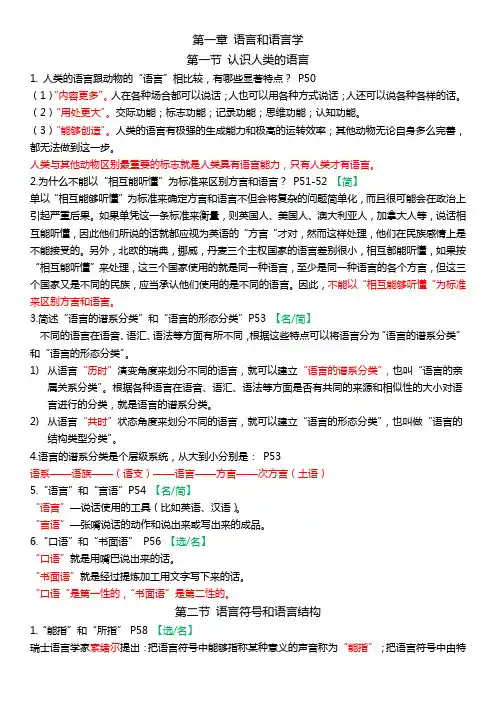
第一章语言和语言学第一节认识人类的语言1.人类的语言跟动物的“语言”相比较,有哪些显著特点?P50(1)“内容更多”。
人在各种场合都可以说话;人也可以用各种方式说话;人还可以说各种各样的话。
(2)“用处更大”。
交际功能;标志功能;记录功能;思维功能;认知功能。
(3)“能够创造”。
人类的语言有极强的生成能力和极高的运转效率;其他动物无论自身多么完善,都无法做到这一步。
人类与其他动物区别最重要的标志就是人类具有语言能力,只有人类才有语言。
2.为什么不能以“相互能听懂”为标准来区别方言和语言?P51-52【简】单以“相互能够听懂”为标准来确定方言和语言不但会将复杂的问题简单化,而且很可能会在政治上引起严重后果。
如果单凭这一条标准来衡量,则英国人、美国人、澳大利亚人,加拿大人等,说话相互能听懂,因此他们所说的话就都应视为英语的“方言“才对,然而这样处理,他们在民族感情上是不能接受的。
另外,北欧的瑞典,挪威,丹麦三个主权国家的语言差别很小,相互都能听懂,如果按“相互能听懂”来处理,这三个国家使用的就是同一种语言,至少是同一种语言的各个方言,但这三个国家又是不同的民族,应当承认他们使用的是不同的语言。
因此,不能以“相互能够听懂“为标准来区别方言和语言。
3.简述“语言的谱系分类”和“语言的形态分类”P53【名/简】不同的语言在语音、语汇、语法等方面有所不同,根据这些特点可以将语言分为“语言的谱系分类”和“语言的形态分类”。
1)从语言“历时”演变角度来划分不同的语言,就可以建立“语言的谱系分类”,也叫“语言的亲属关系分类”。
根据各种语言在语音、语汇、语法等方面是否有共同的来源和相似性的大小对语言进行的分类,就是语言的谱系分类。
2)从语言“共时”状态角度来划分不同的语言,就可以建立“语言的形态分类”,也叫做“语言的结构类型分类”。
4.语言的谱系分类是个层级系统,从大到小分别是:P53语系——语族——(语支)——语言——方言——次方言(土语)5.“语言”和“言语”P54 【名/简】“语言”—说话使用的工具(比如英语、汉语)。
语言学中的语音学知识点总结

语言学中的语音学知识点总结语音学是语言学的一个重要分支,研究的是人类使用语音进行交流的规律和规范。
在语音学中,涉及到了许多重要的知识点,下面将对其中的一些知识点进行总结介绍。
一、语音学的定义和研究对象语音学是语言学的一个分支学科,主要研究人类的语音现象,包括语音的产生、传播和感知。
它关注的是语音的声音学特性以及语音与语音之间的关系。
二、音素和音位音素是语音学中的基本单位,是语言中最小且可以改变词义的语音单位。
而音位则是语言中区分词义的语音单位。
音位是由音素组成的,而不同的语言中,相同的音素可能对应不同的音位。
三、音节音节是由一个或多个音素组成的单位,是构成词汇和语音的基本单元。
一个音节通常由一个核心音素和零个或多个辅音环绕而成。
四、发音部位和发音方法发音部位指的是人类在发音时所使用的口腔、舌头、喉咙等器官。
而发音方法则是指哪些部位接触或靠近以及气流的流通方式。
不同的发音部位和发音方法会产生不同的音素。
五、国际音标国际音标是一种用符号来表示语音的系统。
它包含了各种语音的符号表示,能够准确地记录不同语言中的音素和音位。
国际音标的掌握对于研究和学习语音学非常重要。
六、音变规律音变规律是语音学研究中的一个重要内容,它指的是在语言中,语音发生变化的规律和规定。
音变规律可以是由语音环境所导致的,也可以是由于语音音位本身的改变所引起的。
七、语音规则语音规则是指语言中对于语音的使用所遵循的规范。
这些规范可以包括发音方式、音变规律以及语音之间的联系和组织等。
语音规则是语言交流中一个非常重要的方面。
八、重音与音调重音是语音学中的一个重要概念,它指的是在一个音节中,音量和音高明显地增加。
重音在不同的语言中有不同的表现形式,对于语音的节奏和语调有着重要的影响。
九、声调语言与非声调语言根据语言中是否有音调来区分,可以将语言分为声调语言和非声调语言。
声调语言指的是通过音调的不同来区分词义的语言,如汉语。
而非声调语言则是通过其他方式来区分词义,如英语。
语言学概论重点总结
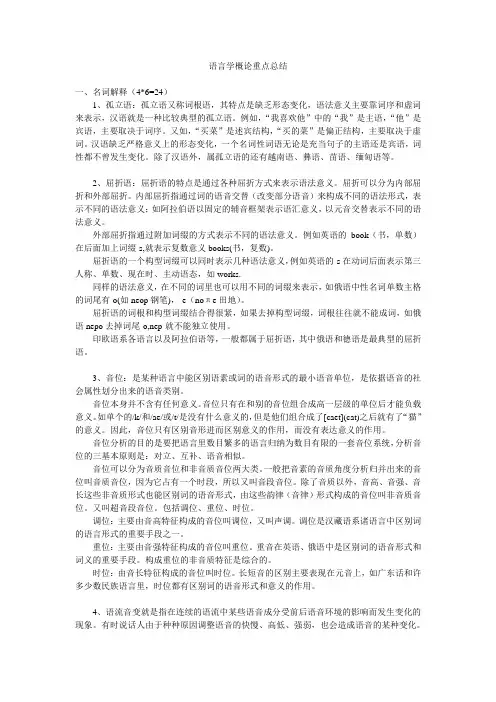
语言学概论重点总结一、名词解释(4*6=24)1、孤立语:孤立语又称词根语,其特点是缺乏形态变化,语法意义主要靠词序和虚词来表示,汉语就是一种比较典型的孤立语。
例如,“我喜欢他”中的“我”是主语,“他”是宾语,主要取决于词序。
又如,“买菜”是述宾结构,“买的菜”是偏正结构,主要取决于虚词。
汉语缺乏严格意义上的形态变化,一个名词性词语无论是充当句子的主语还是宾语,词性都不曾发生变化。
除了汉语外,属孤立语的还有越南语、彝语、苗语、缅甸语等。
2、屈折语:屈折语的特点是通过各种屈折方式来表示语法意义。
屈折可以分为内部屈折和外部屈折。
内部屈折指通过词的语音交替(改变部分语音)来构成不同的语法形式,表示不同的语法意义;如阿拉伯语以固定的辅音框架表示语汇意义,以元音交替表示不同的语法意义。
外部屈折指通过附加词缀的方式表示不同的语法意义。
例如英语的book(书,单数)在后面加上词缀-s,就表示复数意义books(书,复数)。
屈折语的一个构型词缀可以同时表示几种语法意义,例如英语的-s在动词后面表示第三人称、单数、现在时、主动语态,如works.同样的语法意义,在不同的词里也可以用不同的词缀来表示,如俄语中性名词单数主格的词尾有-o(如neop钢笔),-e(noπe田地)。
屈折语的词根和构型词缀结合得很紧,如果去掉构型词缀,词根往往就不能成词,如俄语nepo去掉词尾-o,nep-就不能独立使用。
印欧语系各语言以及阿拉伯语等,一般都属于屈折语,其中俄语和德语是最典型的屈折语。
3、音位:是某种语言中能区别语素或词的语音形式的最小语音单位,是依据语音的社会属性划分出来的语音类别。
音位本身并不含有任何意义。
音位只有在和别的音位组合成高一层级的单位后才能负载意义。
如单个的/k/和/ae/或/t/是没有什么意义的,但是他们组合成了[caet](cat)之后就有了“猫”的意义。
因此,音位只有区别音形进而区别意义的作用,而没有表达意义的作用。
语言学概论—重点知识总结
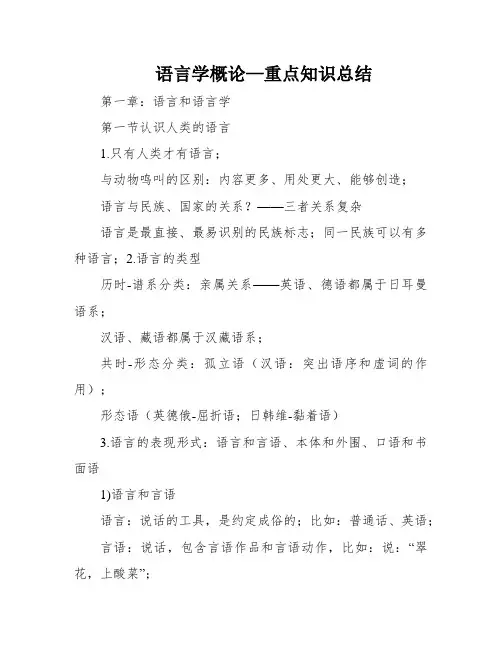
语言学概论—重点知识总结第一章:语言和语言学第一节认识人类的语言1.只有人类才有语言;与动物鸣叫的区别:内容更多、用处更大、能够创造;语言与民族、国家的关系?——三者关系复杂语言是最直接、最易识别的民族标志;同一民族可以有多种语言;2.语言的类型历时-谱系分类:亲属关系——英语、德语都属于日耳曼语系;汉语、藏语都属于汉藏语系;共时-形态分类:孤立语(汉语:突出语序和虚词的作用);形态语(英德俄-屈折语;日韩维-黏着语)3.语言的表现形式:语言和言语、本体和外围、口语和书面语1)语言和言语语言:说话的工具,是约定成俗的;比如:普通话、英语;言语:说话,包含言语作品和言语动作,比如:说:“翠花,上酸菜”;2)选择/名词:本体和外围本体:语言内部包含的要素,比如:语音、语法、语义;外围:语言和其他事物的关系,比如:语言和思维、语言和历史、语言和民族文化;3)口语和口语口语:说的话;第一性的,是书面语产生的基础书面语:写的字;第二性,在口语的基础上,加工提炼而成;第二节语言符号和语言结构1.语言符号必须同时具有表示具体意义的物质实体(红绿灯)和物质实体所表示的特定意义(红灯停绿灯行);2.语言的符号特性:能指和所指、约定和任意、不变和可变;1)能指和所指(口诀:能声所意)能指:把语言符号中能够指称某种意义的声音称为“能指”;所指:把语言符号中有特定声音表示的意义称为“所指”;2)约定和任意约定:人为的规定任意:符号表示意义没有必然联系,只需人人都认定或气就行3)不变和可变可变性的根本原因在于任意性3.语言的结构特性:线性和离散、组合和聚合、层次和层级1)线性和离散:构成语言结构的基础条件;线性:语言符号只能一个一个按工夫顺序成一条线排列;离散性:语言符合可以分解还原成一个一个的符号(词);2)组合和聚合组合:哪一个成分在前、哪一个成分在后的结构特征;(又叫句法功用)聚合:同一类成分可以相互替换的结构特性;3)层次和层级层次:一个小单位内部的成分组合叫做“层次”;(语素组合成词、词组合成词组、词组组合成句子)层级:各个小单位之间的联系叫做“层级”;(词和词一级的内在分别)第三节研究语言的科学1.学科研究的方向分类:本体研究、语言与心理、语言和使用;1)本体研究:对语音、语汇、语法、语义的研究;2)语言与心理研究:语言和心理之间的关系和相互影响;3)语言与应用研究:语言学和信息处理,把理论在实践中的运用;2.语言与哲学1)“名无固宜,约之以命,约定俗成谓之宜……”出自XXX的《正名篇》;2)“小学”包括:《文字学》、《音韵学》、《训诂学》;3.语言研究1)XXX的《通俗语言学教程》提出了“结构主义语言学”“能指和所指”,是结构语言学的奠基人;2)XXX:北美结构主义学家,间接成分分析法;3)乔姆斯基的“转换生成语法”,包括普遍语法、句法自治等观点;第二章语言的物质载体——语音第一节语音概说1.语音:“人说话的声音”,更严格地说,语音是人的发音器官发出的、用于人与人之间交际并表达一定意义的声音。
语言学概论重点总结
语言学概论重点总结一、名词解释(4*6=24 )1、孤立语:孤立语又称词根语,其特点是缺乏形态变化,语法意义主要靠词序和虚词来表示,汉语就是一种比较典型的孤立语。
例如,“我喜欢他”中的“我”是主语,“他”是宾语,主要取决于词序。
又如,“买菜”是述宾结构,“买的菜”是偏正结构,主要取决于虚词。
汉语缺乏严格意义上的形态变化,一个名词性词语无论是充当句子的主语还是宾语,词性都不曾发生变化。
除了汉语外,属孤立语的还有越南语、彝语、苗语、缅甸语等。
2、屈折语:屈折语的特点是通过各种屈折方式来表示语法意义。
屈折可以分为内部屈折和外部屈折。
内部屈折指通过词的语音交替(改变部分语音)来构成不同的语法形式,表示不同的语法意义;如阿拉伯语以固定的辅音框架表示语汇意义,以元音交替表示不同的语法意义。
外部屈折指通过附加词缀的方式表示不同的语法意义。
例如英语的book (书,单数)在后面加上词缀-s,就表示复数意义books(书,复数)。
屈折语的一个构型词缀可以同时表示几种语法意义,例如英语的-s在动词后面表示第三人称、单数、现在时、主动语态,如works.同样的语法意义,在不同的词里也可以用不同的词缀来表示,如俄语中性名词单数主格的词尾有-o(如neop钢笔),-e (no n e田地)。
屈折语的词根和构型词缀结合得很紧,如果去掉构型词缀,词根往往就不能成词,如俄语nepo去掉词尾-o,nep-就不能独立使用。
印欧语系各语言以及阿拉伯语等,一般都属于屈折语,其中俄语和德语是最典型的屈折语。
3、音位:是某种语言中能区别语素或词的语音形式的最小语音单位,是依据语音的社会属性划分出来的语音类别。
音位本身并不含有任何意义。
音位只有在和别的音位组合成高一层级的单位后才能负载意义。
如单个的/k/和/ae/或/"是没有什么意义的,但是他们组合成了[caet](cat)之后就有了 "猫” 的意义。
因此,音位只有区别音形进而区别意义的作用,而没有表达意义的作用。
语言学应用基础知识点总结
语言学应用基础知识点总结语言学是研究语言的学科,它涵盖了语音学、语法学、语义学、语用学等多个方面。
语言学应用基础知识点是学习语言学的重要内容,掌握这些知识点可以帮助我们更深入地了解语言,提高语言表达能力,同时也对语言教育、翻译、交际等领域有着重要的应用价值。
下面就对语言学应用基础知识点进行总结。
一、语音学语音学是研究语音的学科,它主要包括语音的音位、音系、音变规律、语音的分类和描述等内容。
在语言学应用中,语音学主要涉及语音的教学和听力训练。
学生在学习语音学的时候,需要掌握以下几个重要的知识点:1. 国际音标:国际音标是描述语音的国际标准符号,它包括元音和辅音的符号以及相应的发音方法。
学生在学习语音学的时候,需要掌握国际音标的使用方法,能够准确地使用国际音标来表示各种语音。
2. 语音的分类:语音可以分为元音和辅音两种类型,元音是语音的主体部分,而辅音是语音的衬托部分。
学生需要了解元音和辅音的分类方法和区别,能够准确地识别不同的语音。
3. 语音的发音:学生需要了解语音的发音方法,掌握各种语音的发音技巧,能够准确地发出各种语音,同时也能够对口型进行调整,使语音的发音更加标准。
4. 语音的变异规律:语音在不同的语音环境下会发生变异,学生需要了解语音的变异规律,能够正确地理解和使用语音。
语音学的基础知识对语言学应用有着重要的影响,它对提高学生的语音表达能力和听力训练能力有着重要的作用。
二、语法学语法学是研究句子结构和词汇搭配规律的学科,它主要包括句法、语法和语态等内容。
在语言学应用中,语法学主要涉及语法教学和写作训练。
学生在学习语法学的时候,需要掌握以下几个重要的知识点:1. 句子结构:句子是语言的基本单位,学生需要了解句子的组成结构,包括主谓宾结构、主谓宾补结构等,能够正确地分析和理解句子。
2. 词类和句法功能:在语法学的学习中,学生需要掌握各种词类的分类和句法功能,能够准确地识别和使用不同的词类,并了解它们在句子中的作用和地位。
语言学知识点总结
语言学知识点总结一、语言的定义和特点语言是人类交流思想、表达情感、传递信息的一种符号系统。
它具有以下特点:1. 语言是一种符号系统:语言使用具有特定意义的符号来表示事物和概念。
2. 语言具有交流功能:语言是人类交流的工具,通过语言可以传达思想、交流情感、传递信息。
3. 语言具有社会性:语言是社会行为的产物,其形成和发展与人类社会密切相关。
4. 语言具有文化特性:不同语言反映了不同的文化观念和价值体系。
二、语音学语音学是研究语音的科学,主要包括以下内容:1. 音位与音素:语音学将语音分为不同的音位,而音位又由音素组成。
2. 发音器官:语音的产生与发音器官的构造和功能密切相关,如喉、口腔、舌等。
3. 音节与音变:语音学研究了音节的构成和变化规律。
4. 语调和语音语调:语调是语音的音高变化,而语音语调则是语言的音高、音长和音强等变化。
三、语法学语法学是研究语言结构和语言规则的学科,主要包括以下内容:1. 词类与句法关系:语法学将词语分为不同的词类,并研究它们在句子中的作用和关系。
2. 句子结构与语序:语法学研究句子的构成和语序的规律,如主谓宾结构、主谓一致等。
3. 句法关系和语法功能:语法学研究句子中词语之间的关系,如主谓关系、动宾关系等。
4. 语法规则和语法变化:语法学研究了语法规则的形成和变化,如词形变化、语法变异等。
四、语义学语义学是研究语言意义的学科,主要包括以下内容:1. 词义和词汇关系:语义学研究词语的意义和词语之间的关系,如同义词、反义词等。
2. 句义和句子意义:语义学研究句子的意义和句子中词语之间的关系,如逻辑关系、语义角色等。
3. 语用学:语义学研究语言使用中的意义和交际功能,如语境效应、指称和暗示等。
五、语言变化与语言接触语言是动态的,会随着时间的推移而发生变化。
语言变化研究语言变迁的原因和规律,语言接触研究不同语言之间的相互影响和借用现象。
六、语言习得与语言教学语言习得研究儿童和成人习得语言的过程和规律,语言教学研究如何有效地教授和学习语言。
语言学重点概念总结
Design features(定义特征):the distinctive features of human language that essentially make human language distinguishable from languages of animals.Synchronic(共时的):said of an approach that studies language at a theoretical “point” in time. Diachronic(历时的):said of the study of development of language and languages over time. Prescriptive(规定式):to make an authoritarian statement about the correctness of a particular use of language.Descriptive(描写式):to make an objective and systematic account of the patterns and use of a language or variety.Competence(语言能力):unconscious knowledge of the system of grammatical rules in a language.对于一门语言的语法规则系统的无意识获得的知识。
Performance(语言运用):the language actually used by people in speaking or writing.人们说话写作时实际使用的语言。
Langue(语言):the language system shared by a “speech community”.一个“语言社团”共有的语言系统。
- 1、下载文档前请自行甄别文档内容的完整性,平台不提供额外的编辑、内容补充、找答案等附加服务。
- 2、"仅部分预览"的文档,不可在线预览部分如存在完整性等问题,可反馈申请退款(可完整预览的文档不适用该条件!)。
- 3、如文档侵犯您的权益,请联系客服反馈,我们会尽快为您处理(人工客服工作时间:9:00-18:30)。
Design features(定义特征):the distinctive features of human language that essentially make human language distinguishable from languages of animals.Synchronic(共时的):said of an approach that studies language at a theoretical “point” in time.Diachronic(历时的):said of the study of development of language and languages over time.Prescriptive(规定式):to make an authoritarian statement about the correctness of a particular use of language. Descriptive(描写式):to make an objective and systematic account of the patterns and use of a language or variety. Competence(语言能力):unconscious knowledge of the system of grammatical rules in a language.对于一门语言的语法规则系统的无意识获得的知识。
Performance(语言运用):the language actually used by people in speaking or writing.人们说话写作时实际使用的语言。
Langue(语言):the language system shared by a “speech community”.一个“语言社团”共有的语言系统。
Parole(言语):the concrete utterances of a speaker.说话人实际说的话语。
Phonology(音系学):the study of the sound patterns and sound systems of language. It aims to discover the principles that govern the way sounds are organized in languages, and to explain the variations that occur.International Phonetic Alphabet(国际音标):a set of standard phonetic symbols in the form of a chart (the IPA chart), designed by the International Phonetic Association since 1888. It has been revised from time to time to includenew discoveries and changes in phonetic theory and practice.Cardinal Vowels(基本元音):a set of vowel qualities arbitrarily defined, fixed and unchanging, intended to provide a frame of reference for the description of the actual vowels of existing languages.Assimilation(同化现象):a process by which one sound takes on some or all the characteristics of a neighboring sound, a term often used synonymously with “coarticulation”. If a following s ound is influencing a preceding sound, it is called regressive ”assimilation”; the converse process, in which a preceding sound is influencing a following sound, is known as progressive ”assimilation”.Maximal Onset Principle(最大节首原则):a principle for dividing the syllable when there is a cluster of consonants between two vowels, which states that when there is a choice as to where to place a consonant, it is put into theonset rather than the coda.Morpheme(语素):the smallest unit of language in terms of the relationship between expression and content, a unit that cannot be divided into further smaller units without destroying or drastically altering the meaning, whether it is lexical or grammatical.Inflection(屈折变化):is the manifestation of grammatical relationship through the addition of inflectional affixes such as number, person, finiteness, aspect and cases to which they are attached.Derivation(派生词):is the most common word-formation process to be found in the production of new English words. It is accomplished by means of a large number of affixes of English language, and shows the relationship between roots and affixes.Bound morpheme(黏着语素):refer to those which cannot occur alone and mustappear with at least one other morpheme.Free morpheme(自由语素):refer to those which may occur alone or which may constitute words by themselves.Grammatical word(语法词):refer to those which mainly work for constructing group, phrase, clause complex, or even text, such as, conjunctions, prepositions, articles, and pronouns. Grammatical words serve to link together different content parts.Lexical word(词汇词):refer to those which mainly work for referring to substance, action and quality, such as nouns, verbs, adjectives, and adverbs. Lexical words carry the main content of a language.Closed-class(封闭类):A word that belongs to the CLOSED-CLASS is one whose membership is fixed or limited, such as pronouns, prepositions, conjunctions, articles, and others. One cannot easily add or deduce a new member.Open-class(开放类):is one whose membership is in principle infinite or unlimited. When new ideas, inventions, or discoveries emerge, new members are continually and constantly being added to the lexicon. Nouns, verbs, adjectives, and many adverbs are all open-class items.Syntax(句法):the study of the rules governing the ways different constituents are combined to form sentences in a language, or the study of the interrelationships between elements in sentence structures.Co-occurrence(共现):It means that words of different sets of clauses may permit, or require, the occurrence of a word of another set or class to form a sentence or a particular part of a sentence.Endocentric(向心结构):endocentric construction is one whose distribution is functionally equivalent to that of one or more of its constituents, which servesas a definable Center or Head of the whole. Exocentric(离心结构):exocentric construction refers to a group of syntactically related words where none of the words is functionally equivalent to the group as a whole, that is, there is no definable “Centre” or “Head” inside the group.Subordination(从属关系):refers to the process or result of linking linguistic units so that they have different syntactic status, one being dependent upon the other, and usually a constituent of the other. The subordinate constituents are words which modify the head. Consequently, they can be called modifiers.Coordination(并列):a common syntactic pattern in English and other languages formed by grouping together two or more categories of the same type with the help of a conjunction such as and, but and or . Cohesion:refers to relations of meaning that exist withinthe text, that define it as a text.Synonymy(同义关系):synonymy is the technical name for one of the sense relations between linguistic units, namely the sameness relation.Semantic components(语义成分):semantic components, or semantic features, are semantic units smaller than the meaning of a word. For example, the meaning of the word boy may be analysed into three components: HUMAN, YOUNG and MALE.Psycholinguistics(心理语言学): psycholinguistics is the study of psychological aspects of language; it usually studies the psychological states and mental activity associated with the use of language. As an interdisciplinary academic field based on psychology and linguistics, psycholinguistics investigates the six following subjects: language acquisition, language comprehension, language production, language disorders,language and thought, and cognitive architecture of language, The most important research subjects are acquisition, comprehension and production. Language acquisition(语言习得):language acquisition is one of the central topics in psycholinguistics. Acquiring a first language is something every child does successfully, in a matter of a few years and without the need for formal lessons. Four phases are identified and acknowledged in the process of language acquisition: holophrastic stage, two-word stage, three-word utterances, and, fluent grammatical conversation stage.cohort model(集群模型):The cohort model is a supposed doctrine dealing with the spoken word recognition postulated by Marslen-Wilson and Welsh in 1990, it is suggested that the first few phonemes of a spoken word activate a set or cohort of word candidates that are consistent with the input. These candidates compete with one another for activation. As more acoustic input is analyzed, candidates that areno longer consistent with the input drop out of the set. This process continues until only one word candidate matches the input; the best fitting word may be chosen if no single candidate is a clear winner.interactive model(交互模型):The interactive model holds that in recognizing the spoken words higher processing levels have a direct, “top-down” influence on lower levels. Lexical knowledge can affect the perception of phonemes. There is interactivity in the form of lexical effects on the perception of sublexical units. In certain cases, listeners’ knowledge of words can lead to the inhibition of certain phonemes; in other cases, listeners continue to “hear” phonemes that have been removed from the speech signal and replaced by noise.serial model(串行模型):Serial model proposes that the sentence comprehension system continually and sequentially follows the constraints of a language’s grammar with remarkable speed.Serial model describes how the processor quickly constructs one or more representations of a sentence based on a restricted range of information that is guaranteed to be relevant to its interpretation, primarily grammatical information. Any such representation is then quickly interpreted and evaluated, using the full range of information that might be relevant. parallel model(并行模型):Parallel model emphasizes that the comprehension system is sensitive to a vast range of information, including grammatical, lexical, and contextual, as well as knowledge of the speaker/writer and of the world in general. Parallel model describes how the processor uses all relevant information to quickly evaluate the full range of possible interpretations of a sentence. It is generally acknowledged that listeners and readers integrate grammatical and situational knowledge in understanding a sentence.figure-ground alignment(图形-背景关系): Figure-ground alignment seems to apply to spacewith the ground as the prepositional object and the preposition expressing the spatial relational configuration. It also applies to human perception of moving objects. Since the moving object is typically the most prominent one, because it is moving, it is typically the figure, while the remaining stimuli constitute the ground.basic level category(基本层次范畴):Basic level category is the most economical level at which you can find the most relevant information. The information on our interactions with objects in the real world are stored at this level. It is at this level that we conjure up the general gestalt of the category.image schema(意象图式):Image schema is a recurring, dynamic pattern of our perceptual interactions and motor programs that gives coherence and structure to our experience.Metaphor(隐喻):Metaphor involves the comparison of two conceptsin that one is construed in terms of the other. It’s often described in terms of a target domain and a source domain. The target domain is the experience being described by the metaphor and the source domain is the means that we use in order to describe the experience.Metonymy(转喻):Metonymy is a figure of speech that has to do with the substitution of the name of one thing for that of another.Communicative Competence(交际能力):is a sociolinguistic rule put forward by Dell Hymes in contrast with the “competence” vs. “performance” dichotomy in theoretic linguistics.Context of Situation(语境理论):is a framework put forward by Firth. This theory has the following elements (Firth, 1950: 43-44 [Palmer, 1981: 53-54]).A. The relevant features of the participants: persons, personalities:(i) The verbal action of the participants. (ii) The non-verbal action of the participants.B. The relevant objects.C. The effects of the verbal action.Ethnography of Communication(交际民族学):is an authoritative research framework of our time in a linguistic study of social and cultural factors (Hymes, 1962).Speech Community(话语群体):refers to a group of pe ople who “share not only the same rules of speaking, but at least one linguistic variety as well.” (Hymes, 1972: 52) SPEAKING: is a mnemonic way of summarizing certain components of speech which make possible the description and analysis of communicative behavior: S=Situation(场景), P=Participants (参与者), E=Ends(目的), A=Act sequence(相关形式与内容), K=Key(语气), I=Instrumentalities (语式), N=Norms(准则), and G=Genres(体裁). Sapir-Whorf Hypothesis(萨丕尔--沃尔夫假设):is a theoretic assumption which suggests that our language helps mould our way of thinking and,consequently, different languages may probably express speakers' unique ways of understanding the world. In a loose sense, this term can be interchangeably used with linguistic relativity and linguistic determinism.Variationist Linguistics(语言变体):is a theoretic framework advanced by William Labov to study how language variation and change take place in different social contexts or geographic districts under the influence of social factors such as economics, education, class, gender, style, and so on. The method it uses is basically quantitative, but qualitative instruments have recently been introduced in this branch of linguistic research for a better description and explanation of the data collected.performative(施为句):A performative is a sentence like “I name this ship the Queen Elizabeth”, which does not describe things and cannot be said to be true orfalse. The uttering of a performative sentence is, or is a part of, the doing of an action. Verbs like “name” are known as performative verbs. locutionary act(发话行为):The locutionary act is the ordinary act we perform when we speak, i.e. we move our vocal organs and produce a number of sounds, organized in a certain way and with a certain meaning. For example, when somebody says “Morning!”, we could say he produced a sound, word or sentence—“Morning!”perlocutionary act(取效行为):The perlocutionary act concerns the consequential effects of a locution upon the hearer. By telling somebody something the speaker may change the opinion of the hearer on something, or mislead him, or surprise him, or induce him to do something, etc. Whether or not these effects are intended by the speaker, they can be regarded as part of the act that the speaker has performed. illocutionary act(行事行为):The illocutionary act is the act performed in the performing of a locutionary act. When we speak wenot only produce some units of language with certain meanings, but also make clear our purpose in producing them, the way we intend them to be understood, or they also have certain forces as Austin prefers to say. In the example of “Morning!” we can say it has the force of a greeting, or it ought to have been taken as a greeting.cooperative principle(合作原则):This is the principle suggested by Grice about the regularity in conversation, which reads “Make your conversational contribution such as is required, at the stage at which it occurs, by the accepted purpose or direction of the talk exchange in which you are engaged”. There are four categories of maxims under it, namely, quantity maxims, quality maxims, relation maxim, and manner maxims.conversational implicature(会话含义):This is a type of implied meaning, which is deduced on the basis of the conventional meaning of words together with the context, under theguidance of the CP and its maxims. In this sense, implicature is comparable to illocutionary force in speech act theory in that they are both concerned with the contextual side of meaning, or 言外之意in Chinese.entailment(衍推):This is a logical relationship between two sentences in which the truth of the second necessarily follows from the truth of the first, while the falsity of the first follows from the falsity of the second. For example, when “I saw a boy” is true, “I saw a child” is necessari ly true; and if “I saw a child” is not true, “I saw a boy” will not be true either.third-person narrator(第三人称叙述者):If the narrator is not a character in the fictional world, he or she is usually called a THIRD-PERSON NARRATOR, because reference to all the characters in the fictional world of the story will involve the use of the third-person pronouns, he, she, it or they. This type of narrator isarguably the dominant narrator type.i-narrator(第一人称叙述者):The person who tells the story may also be a character in the fictional world of the story, relating the story after the event. In this case the critics call the narrator a FIRST-PERSON NARRATOR or I-NARRATOR because when the narrator refers to himself or herself in the story the first person pronoun I is used. First-person narrators are often said to be “limited” because they don't know all the facts or “unreliable” because they trick the reader by withholding information or telling untruths. This often happens in murder and mystery stories.concordance(共现索引):sorting the data in some way, for example, alphabetically on words occurring in the immediate context of the word.corpus(语料库):a collection of linguistic data, either compiled as written texts or as a transcription of recordedspeech. The main purpose of a corpus is to verify a hypothesis about language, for example, to determine how the usage of a particular sound, word, or syntactic construction varies.。
